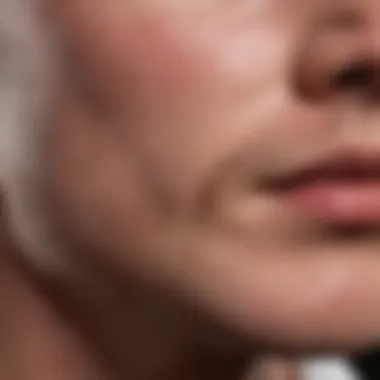Understanding Red Bumps After Shaving: Causes & Solutions


Intro
Shaving can often feel like a double-edged sword. It promises a fresh, clean look but can sometimes leave behind those pesky red bumps that seem to pop up just like that, out of nowhere. Understanding the causes behind this skin irritation is essential in not only achieving that smooth finish but also in enhancing overall skin health. Many men find themselves asking, Why does this happen to me? or How can I avoid looking like a raspberry?
In the journey to uncover the reasons for post-shave red bumps, it’s crucial to look at various factors. These include skin type, shaving techniques, and the tools used. Grooming is not just about looking smart; it’s about feeling good in your skin too. A well-groomed appearance can build confidence, especially in social and professional circles.
As we delve into this topic, we will examine everything from the anatomy of the skin to the proper shaving techniques that can help minimize issues. Let’s jump right in and unpack this common plight for many men.
Prelims to Post-Shaving Bumps
Every man at some point grapples with the aftermath of shaving; the pesky, often irritating red bumps that can crop up after a clean shave. Understanding these post-shaving bumps isn’t just a cosmetic concern but rather a key aspect of maintaining overall skin health. For those who prioritize grooming, these bumps can tarnish the polished appearance that grooming aims to achieve.
Overview of Shaving and Its Skin Impact
Shaving is more than just a routine; it’s an art form that involves precise techniques and a touch of care. When you glide a razor over your skin, you might think it merely removes hair. However, this act can provoke various reactions within your skin.
The skin is a complex organ, consisting of several layers that each serve unique purposes. Shaving can disturb these layers, leading to issues such as irritation or inflammation. Understanding how your specific skin type interacts with different shaving methods is crucial. Whether you have oily, dry, or combination skin, the effects can significantly vary.
For example, a multi-blade razor might provide a closer shave, but it can also increase the likelihood of irritation for some individuals, especially those with sensitive skin. Using a single-blade safety razor, on the other hand, reduces the risk of nicks and bumps, leading to a smoother experience.
Moreover, the choice of shaving cream or gel plays a pivotal role in this narrative. Ingredients that are soothing to the skin can minimize irritation, while those with fragrances or certain preservatives can aggravate it.
Significance of Understanding Red Bumps
Recognizing the factors that contribute to red bumps after shaving can be the difference between a seamless grooming routine and an annoying, skin-drying hassle. If you find yourself facing frequent breakouts, it’s worth delving into the whys and hows of your shaving practice.
"Addressing the root causes of these red bumps can help in crafting a bespoke grooming experience tailored to your skin's needs."
So what’s at stake? Well, comfort is a significant factor. No one enjoys the sting of irritated skin, especially when dressing up for an important event or casual get-together. Additionally, persistent bumps can lead to post-inflammatory hyperpigmentation, a condition that can leave marks long after the initial irritation has faded.
By understanding the causes of red bumps—be it improper shaving techniques, skin type issues, or the products used—you can take informed steps to avoid those unwanted occurrences. Investing time in learning about this topic may not only save you from discomfort but also elevate your grooming game, ensuring that your appearance remains sharp and well-maintained.
The Anatomy of Skin and Shaving
Understanding the anatomy of skin and its relation to shaving is instrumental in addressing post-shaving red bumps. When you shave, it’s not just hair you're dealing with; you’re interacting with a complex organ that plays a vital role in your overall health and appearance. Knowing about skin layers, hair follicles, and different skin types can provide insights into why those annoying red bumps appear after your grooming routine.
Layers of the Skin
The skin comprises three primary layers: the epidermis, dermis, and hypodermis. Each layer has distinct functions that influence how it reacts to shaving.
- Epidermis: This is the outermost layer and acts as a protective barrier. It's thinner than the other layers and, when damaged by improper shaving techniques, can lead to irritation and redness.
- Dermis: Underneath the epidermis lies the dermis, which houses blood vessels, hair follicles, and sweat glands. The condition of this layer can affect healing processes and overall comfort after shaving.
- Hypodermis: This is the deepest layer, which contains fat and connective tissue. While it is less involved in immediate shaving irritation, it contributes to skin's elasticity and resilience.
Understanding these layers and their functions helps in recognizing how shaving can disrupt your skin's natural balance and lead to issues like red bumps.
Hair Follicles and Their Role
Hair follicles are fundamentally crucial in the shaving experience. These small openings in your skin not only hold the hair but also play a role in your skin’s health.


- Each follicle is surrounded by sebaceous glands that produce oils to keep hair moisturized and the skin protected.
- When shaving, the blade often disturbs these follicles, resulting in irritation. If the hair follicles become clogged or inflamed, it can lead to painful bumps.
- In some cases, when the hair grows back, it may curl back into the skin, creating what’s known as ingrown hairs, which exacerbate bump formation.
In essence, maintaining healthy hair follicles is crucial for avoiding the unpleasant aftereffects of shaving.
How Shaving Affects Skin Types
Not all skin types are created equal. Depending on whether your skin is oily, dry, or sensitive, the shaving experience can vary widely.
- Oily Skin: Often more resistant to irritation due to the natural oils acting as a barrier, yet still susceptible to acne when combined with blade-blocking sebum.
- Dry Skin: This skin type may react poorly to shaving, leading to tightness and irritation. Proper hydration before and after shaving can help mitigate these effects.
- Sensitive Skin: prone to reactions and redness, this type requires special attention. Using a gentle razor and non-irritating shaving cream is crucial to prevent bumps and irritation.
Understanding how your specific skin type interacts with shaving routines can guide you to make better choices and reduce negative skin reactions.
"Knowledge of your skin's anatomy and your hair's behavior during shaving can make all the difference between a smooth finish and unsightly bumps."
With this foundation set, you will be better prepared to tackle the next sections on identifying red bumps, preventing them, and treating the aftermath.
Identifying Red Bumps: Causes
Understanding the various causes of red bumps post-shaving is paramount for anyone keen on maintaining a polished appearance. These bumps can detract from the finest grooming routines and might even discourage a man from using the razor altogether. Identifying the root causes behind these red bumps not only helps in addressing the immediate issue but also empowers individuals to implement measures that enhance their shaving technique over time. Recognizing the specific triggers can guide users in choosing products and methods that work best for their skin type, thus fostering a smoother, irritation-free shave.
Irritation from Shaving Techniques
Shaving techniques play a pivotal role in how the skin reacts post-shave. Not all men wield their razors with the same finesse, and variations in technique can lead to differing degrees of skin irritation. For example, using excessive pressure on the razor while shaving can scrape off layers of skin, causing inflammation and red bumps to appear. Additionally, shaving against the hair grain often leads to discomfort, as it can pull at hair follicles. The careful approach of moving with the direction of hair growth is key to minimizing irritation.
- Key considerations include:
- Learning the right angle of the razor blade to avoid skin trauma.
- Opting for shorter strokes rather than long sweeps, which can lead to uneven pressure on the skin.
- Acknowledging the importance of a pre-shave routine that prepares and soothes the skin may change the game entirely.
Allergic Reactions to Products
Many grooming products boast flashy marketing that might catch the eye, but what about their ingredient lists? Some men might find themselves allergic or sensitive to ingredients commonly found in shaving creams, gels, or aftershaves. Preservatives, perfumes, and alcohol often lead to reactions, manifesting as itchy, red bumps. It’s crucial to examine the components of each product used on the skin. An allergy patch test is something to consider for those trying new products.
- Common irritants include:
- Fragrance chemicals, which can trigger outbreaks.
- Alcohol-based products, leading to a drying effect that aggravates the skin.
- Certain oils or botanical extracts that some individuals do not tolerate well.
Ingrown Hairs and Their Effects
Ingrown hairs present a unique challenge after shaving and can often be a painful ordeal. When hair grows back into the skin instead of outwards, it causes an inflammatory response, resulting in bumps. This is particularly common in those with curly or coarse hair. Identifying this issue is critical because ingrown hair can lead to infection and persistent skin issues if not addressed promptly.
- To mitigate ingrown hairs:
- Employ methods such as exfoliating before shaving, as this can help remove dead skin cells that might be trapping hair.
- Consider using a sharp blade and changing it regularly to avoid tugging at the hair.
- Utilizing post-shave products designed to soothe and prevent ingrown hairs aids significantly in recovery.
Bacterial Infections Post-Shaving
Finally, bacterial infections can complicate what should be a simple grooming habit. It's easy for tiny nicks and cuts to occur during shaving, creating an entry point for bacteria. If proper hygiene isn’t followed, these cuts might become infected. Symptoms may include redness, swelling, and pus-filled bumps, which highlight the need for an immediate response.
- Preventive measures include:


- Keeping razors clean and disinfected, ideally with alcohol or antibacterial solutions.
- Avoiding the use of shared razors, as this can increase the risk of infection.
- Quickly treating any cuts with antiseptic products to reduce the risk of complications.
Understanding these causes allows for informed decisions regarding products and techniques, ultimately contributing to a more refined and well-kept appearance.
Preventing Red Bumps When Shaving
Preventing red bumps when shaving is not just an afterthought; it's a crucial part of maintaining the health of your skin. This section dives into essential steps you can take to minimize irritation and enhance your grooming experience. Thoughtful prevention strategies not only allow for a smoother shave but also contribute to long-term skin health. Healthy skin boosts confidence and ensures that your facial appearance aligns with your fashion-forward lifestyle. Understanding this topic means you can effectively ward off not just immediate discomfort but potential skin issues down the line.
Choosing the Right Razor
Selecting the right razor can be a game changer in your shaving routine. Not all razors are created equal, and the choice you make can greatly affect your skin’s reaction.
- Safety razors are gentle on the skin and offer a close shave without excessive irritation. They allow you to control the pressure applied, which is often key in avoiding razor bumps.
- Cartridge razors are convenient and often easier for beginners; however, using a multi-blade razor can increase the chances of skin irritation due to the multiple passes over the same area.
- Be cautious with electric razors as well. They may not provide as close a shave, but they reduce the chances of cuts and rashes.
Always choose a razor that caters to your hair type and skin sensitivity. If you have sensitive skin, a single-blade safety razor might be your best bet to minimize contact that leads to irritation.
Preparing the Skin Before Shaving
Prepping your skin is a vital step that can make or break your shaving experience. Start by washing your face with warm water to open up the pores and soften your facial hair. This not only reduces friction but also allows for a closer shave.
- Exfoliation beforehand can be very beneficial too. Use a gentle scrub or an exfoliating brush to remove dead skin cells that could clog your razor. This will help in preventing ingrown hairs.
- Applying a quality pre-shave oil or cream can create a protective barrier on your skin, further reducing friction and irritation.
- Remember, patience is a virtue. Spend a few extra minutes on this prep phase; it’ll pay dividends once you start shaving.
Post-Shave Skin Care Routine
Your skin deserves some nice TLC after the shave, and how you treat it can significantly impact the likelihood of red bumps. Consider these steps for an effective post-shave routine:
- Cool down your skin: Rinse your face with cool water to close the pores. This can help minimize irritation.
- Apply alcohol-free aftershave: Look for soothing lotions or balms containing ingredients like aloe vera or chamomile that nourish and hydrate the skin.
- Moisturize: A high-quality face moisturizer is essential. It hydrates the skin and helps in the healing process, keeping irritation at bay.
"Invest in your skin; it’s going to represent you for a long time."
Incorporating these steps into your grooming regimen can lead to healthier skin and prevent those pesky bumps from invading your shaving routine. Focusing on every aspect, from choosing the right tools to establishing a solid aftercare routine, is essential for maintaining a polished and stylish look.
Effective Treatments for Post-Shaving Bumps
When it comes to post-shaving bumps, understanding effective treatments is crucial for maintaining skin health and comfort. Having a solid game plan can minimize discomfort and allow individuals to focus more on looking sharp rather than battling skin irritations. This section will explore various treatment options, ensuring that after every shaving session, your skin isn’t just surviving, but thriving.
Topical Treatments for Relief
After shaving, many individuals might reach for creams or gels to soothe irritated skin. But not all treatments are created equal. Here are common topical solutions to consider:
- Hydrocortisone Cream: This is a low-dose steroid that can temporarily relieve itching and irritation. It's best used sparingly and not as a long-term solution.
- Aloe Vera Gel: Renowned for its soothing properties, aloe vera hydrates and calms irritated skin. It’s a natural choice and can help speed up the healing process.
- Salicylic Acid: Widely used for acne, salicylic acid can also tackle those pesky red bumps by helping to unclog hair follicles.
- Tea Tree Oil: Known for its antibacterial and anti-inflammatory properties, this oil can help reduce redness and prevent infections.
Applying these treatments right after shaving can provide immediate relief and prevent further irritation. Just remember, it's worth performing a patch test beforehand to avoid any allergic reactions.
Natural Remedies to Consider
For those who prefer a more holistic approach, various natural remedies can aid in treating post-shaving bumps effectively. Some options range from kitchen staples to garden favorites:
- Coconut Oil: This multi-use oil is incredible for its moisturizing effects. When applied post-shave, it helps lock in hydration and provides anti-inflammatory benefits.
- Chamomile Tea Compress: Brew chamomile tea, let it cool, and soak a cloth in it. This can be gently pressed against the bumps, leveraging chamomile's soothing properties to reduce swelling.
- Oatmeal Masks: Ground oatmeal mixed with water can create a paste that soothes the skin. Oatmeal is known for its anti-inflammatory benefits, making it a solid choice for calming irritated areas.


Exploring these natural alternatives offers gentle, effective options that often have fewer side effects than commercial products.
When to Seek Professional Help
While many at-home treatments can be effective, there are instances when seeking professional help is the best course of action. If you experience:
- Persistent Bumps: If your skin doesn't respond to over-the-counter treatments and bumps remain for an extended period, consulting a dermatologist is essential.
- Severe Pain or Discomfort: Intense pain associated with shaving bumps could signify something more serious, and it’s essential to get a professional’s opinion.
- Signs of Infection: If there is increased redness, warmth, or pus, it's time to reach out to a healthcare professional. Identifying and treating infections early can prevent complications.
Remember: Your skin is unique, and what works for one person might not work for another. Being in tune with your skin's needs ensures long-term care and effective management of shaving-related issues.
Long-Term Skin Health and Maintenance
Long-term skin health is not something to take lightly, especially for those who take pride in their grooming. The skin is a reflection of overall health, and maintaining it goes beyond just quick fixes. It’s about establishing habits that foster a smooth and radiant complexion. Understanding the significance of proper skin maintenance can make a world of difference in preventing those pesky red bumps that often follow shaving. Here are vital components to ensure your skin stays in tip-top shape.
Establishing a Skin Care Routine
Creating an effective skin care routine may feel overwhelming, but breaking it down into manageable tasks can simplify the process. Consistency is key.
- Cleansing: Start each day with a gentle cleanser suited for your skin type. For example, a gel-based product can work wonders on oily skin, whereas cream-based cleansers are ideal for those with dry skin.
- Exfoliation: Incorporate exfoliation into your routine at least twice a week. Not only does this help to remove dead skin cells, but it can also prevent ingrown hairs, a common culprit behind irritation after shaving.
- Moisturizing: A good moisturizer is your best friend. It helps to restore hydration and creates a barrier against environmental stressors. Choose one that aligns with your skin type.
- Sunscreen: Never underestimate the power of sunscreen. It’s essential for protecting your skin, even on cloudy days. A broad-spectrum SPF 30 should be part of your daily routine.
Importance of Hydration and Nutrition
What goes into our bodies reflects on our skin. Hydration plays a pivotal role in maintaining a healthy complexion. Drinking an adequate amount of water can keep your skin supple and reduce the likelihood of redness or irritation after shaving. Here are some tips to keep in mind:
- Hydrate: Aim for at least eight glasses of water a day. If plain water feels boring, try adding slices of lemon or berries for flavor.
- Balanced Diet: Incorporate fruits, vegetables, and lean proteins into your meals. Nutrient-rich foods, such as vitamins A, C, and E, as well as omega-3 fatty acids, work wonders for your skin health.
- Avoiding Excess Sugar: High sugar consumption can lead to inflammation, which increases the risk of red bumps after shaving. Moderation is key.
Never underestimate the link between nutrition and skin health. A well-nourished body is a critical ally in your quest for smooth skin.
Regular Dermatological Consultations
Consulting with a dermatologist doesn’t just require waiting until a problem arises; it's a proactive strategy for long-term skin health. Regular visits can help tailor a skin care regimen specifically for you based on your individual needs. Benefits include:
- Personalized Advice: Dermatologists can recommend products that will suit your skin type and concerns, helping to mitigate common issues like redness or bumps.
- Professional Treatments: Sometimes over-the-counter products aren’t enough. A dermatologist can provide treatments like chemical peels or microdermabrasion that could significantly enhance your skin.
- Early Detection: Regular check-ups can help catch any skin conditions early on, minimizing potential damage and complications.
By incorporating these components into a comprehensive skin care strategy, you can achieve not only short-term relief from post-shaving bumps but also foster resilient, healthy skin in the long run. Invest in your skin; after all, it’s the only one you've got.
The End: Achieving Healthy Skin After Shaving
In the realm of grooming, understanding how to maintain healthy skin post-shave is paramount. Addressing the issue of red bumps not only enhances personal appearance but also impacts self-confidence. This article has extensively laid out the nuances surrounding red bumps that often plague the skin after shaving. The significance of nurturing one’s skin cannot be overstated; it’s about achieving that fresh, smooth finish that everyone desires.
Recap of Key Points
- Identifying Causes: We explored irritation from shaving techniques, allergic reactions, ingrown hairs, and bacterial infections. Recognizing these causes is crucial for effective management.
- Prevention Strategies: Choosing the right razor, properly preparing the skin before shaving, and establishing a post-shave care routine can go a long way in minimizing bumps.
- Treatment Options: We outlined topical treatments and natural remedies that can soothe irritated skin and provide relief. In cases of persistent issues, seeking professional guidance is advisable.
- Use razors with multiple blades for a cleaner cut.
- Always hydrate skin before shaving, using warm water and quality shaving creams.
- After shaving, treat the skin to soothing aftershave lotions to reduce inflammation.
Encouragement for Best Practices
Encouragement lies in the commitment to develop a consistent skincare routine. Here are a few best practices to integrate into your routine:
- Always test products: If you’re trying a new product, conduct a patch test to avoid unpleasant surprises.
- Stay hydrated: Keeping your skin hydrated from within has benefits that reflect on your face.
- Regular exfoliation: This helps in preventing ingrown hairs and maintaining a smooth texture by removing dead skin cells.
- Listen to your skin: What works for one may not work for another. Be mindful of how your skin reacts and adjust routines accordingly.
"Beauty begins the moment you decide to be yourself.” – Coco Chanel
Ultimately, adopting a mindful approach to grooming isn't just about looking good; it’s about feeling good too. Maintain a healthy practice, educate yourself on skin health, and most importantly, enjoy the process of self-care. Your skin is a reflection of the effort you put into it.















